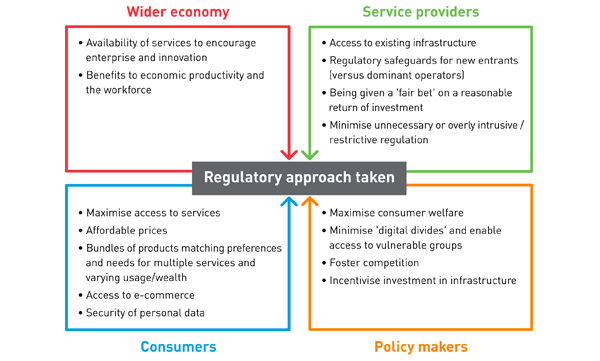Achieving fit-for-purpose regulation in developing markets is challenging, but possible
NRAs in developing economies often have to design their own regulation in challenging conditions
For many years, tried and tested frameworks for the analysis of telecoms markets have been in place in developed economies such as those in the EU. However, national regulatory authorities (NRAs) in other regions of the world (such as Africa, smaller island states and Asia) are often faced with designing their own regulatory regimes to meet specific national priorities. These vary from country to country.
The process must often be completed with fewer resources than would be available in a developed country. The regulatory regimes must also address issues of competition that may be unique to each market (for example, the presence of highly dominant operators), imbalanced (that is, non-cost-reflective) tariffing, a lack of infrastructure access and the difficulty of making returns from a population with a low disposable income. This is a considerable challenge.
NRAs need to balance the needs of all stakeholders (consumers, service providers and the wider economy), as illustrated in Figure 1. The stakes are high, since telecoms services are absolutely central to facilitating national economic growth.
Figure 1: Balancing the needs of stakeholders when designing a regulatory approach

Source: Analysys Mason, 2019
Targeted regulation can help to redress market failures in an efficient manner
NRAs may encounter a number of problems without the guidance of an overarching framework. To avoid these, the following recommendations should be taken into account.
- The relevant market definition(s) should be suitable in scope.
- The remedies imposed should be appropriate.
- The remedies should be well-designed to fit with the resources available.
We consider these in turn below.
The relevant market definition(s) should be suitable in scope
The scope and number of relevant markets defined and then analysed should be such that product substitutability can be easily determined, the impact/relevance to consumers can be understood and a clear-cut assessment of dominance is possible.
The remedies imposed should be appropriate
Remedies create a direct cost impact on both the regulated party and the NRA. The former must implement the remedy while the latter must monitor the implementation. It makes little sense to impose all possible remedies (a ‘scattergun’ approach) in the hope that some of them lead to positive changes in the market, given the constraints on resources. Some remedies such as accounting separation and cost-orientation can require significant time and investment to implement. Remedies should be imposed because they are proportionate, rather than just because they are remedies that other NRAs have used; they should directly target the specific market failure.
The remedies should be well-designed to fit with the resources available
Regulators have a wide range of remedies that can be used, and the level of sophistication required to implement them varies.
- Lower sophistication. Simpler remedies include benchmarking, reference offers, obligations to negotiate/conclude agreements, retail pricing prohibitions, non-discrimination obligations and mandated access.
- Moderate sophistication. Examples of remedies with a moderate level of sophistication are accounting separation, retail price caps, ‘fair and reasonable’ obligations and top-down cost models.
- Higher sophistication. Highly sophisticated remedies include bottom-up cost models, basket-based price caps and economic replicability/margin squeeze tests.
The construction of bottom-up cost models for price setting in particular may require a significant amount of detailed information that is neither readily available nor collected by operators. In this case, NRAs may ‘pool’ available data from all operators instead. The key point is that a sophisticated remedy (assuming it is the targeted appropriate solution to the market failure at hand) needs to be achievable with the data, expertise and resources that are available.
Analysys Mason has more than 30 years of expertise in regulatory analysis and can therefore provide expert support on these issues
Designing regulation to address issues in developing economies, particularly where a tried and tested framework is lacking, can be challenging, but possible. The key for NRAs is to ensure that the regulation that is designed is robust, targeted and proportionate.
If you are interested in discussing some of the issues on telecoms regulation that are outlined in this piece, please contact Matthew Starling or Ian Streule.
Downloads
Article (PDF)Authors

Matthew Starling
Principal

